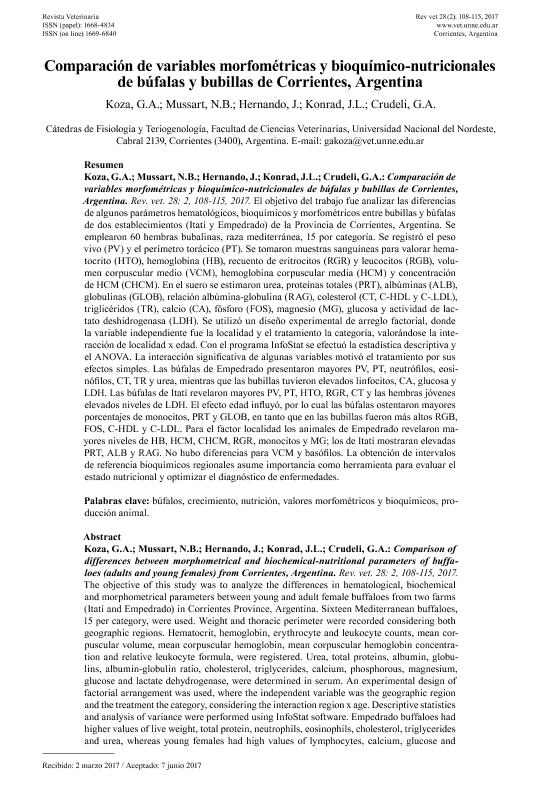Artículo
El objetivo del trabajo fue analizar las diferencias de algunos parámetros hematológicos, bioquímicos y morfométricos entre bubillas y búfalas de dos establecimientos (Itatí y Empedrado) de la Provincia de Corrientes, Argentina. Se emplearon 60 hembras bubalinas, raza mediterránea, 15 por categoría. Se registró el peso vivo (PV) y el perímetro torácico (PT). Se tomaron muestras sanguíneas para valorar hematocrito (HTO), hemoglobina (HB), recuento de eritrocitos (RGR) y leucocitos (RGB), volumen corpuscular medio (VCM), hemoglobina corpuscular media (HCM) y concentración de HCM (CHCM). En el suero se estimaron urea, proteínas totales (PRT), albúminas (ALB), globulinas (GLOB), relación albúmina-globulina (RAG), colesterol (CT, C-HDL y C-.LDL), triglicéridos (TR), calcio (CA), fósforo (FOS), magnesio (MG), glucosa y actividad de lactato deshidrogenasa (LDH). Se utilizó un diseño experimental de arreglo factorial, donde la variable independiente fue la localidad y el tratamiento la categoría, valorándose la interacción de localidad x edad. Con el programa InfoStat se efectuó la estadística descriptiva y el ANOVA. La interacción significativa de algunas variables motivó el tratamiento por sus efectos simples. Las búfalas de Empedrado presentaron mayores PV, PT, neutrófilos, eosinófilos, CT, TR y urea, mientras que las bubillas tuvieron elevados linfocitos, CA, glucosa y LDH. Las búfalas de Itatí revelaron mayores PV, PT, HTO, RGR, CT y las hembras jóvenes elevados niveles de LDH. El efecto edad influyó, por lo cual las búfalas ostentaron mayores porcentajes de monocitos, PRT y GLOB, en tanto que en las bubillas fueron más altos RGB, FOS, C-HDL y C-LDL. Para el factor localidad los animales de Empedrado revelaron mayores niveles de HB, HCM, CHCM, RGR, monocitos y MG; los de Itatí mostraran elevadas PRT, ALB y RAG. No hubo diferencias para VCM y basófilos. La obtención de intervalos de referencia bioquímicos regionales asume importancia como herramienta para evaluar el estado nutricional y optimizar el diagnóstico de enfermedades. The objective of this study was to analyze the differences in hematological, biochemical and morphometrical parameters between young and adult female buffaloes from two farms (Itatí and Empedrado) in Corrientes Province, Argentina. Sixteen Mediterranean buffaloes, 15 per category, were used. Weight and thoracic perimeter were recorded considering both geographic regions. Hematocrit, hemoglobin, erythrocyte and leukocyte counts, mean corpuscular volume, mean corpuscular hemoglobin, mean corpuscular hemoglobin concentration and relative leukocyte formula, were registered. Urea, total proteins, albumin, globulins, albumin-globulin ratio, cholesterol, triglycerides, calcium, phosphorous, magnesium, glucose and lactate dehydrogenase, were determined in serum. An experimental design of factorial arrangement was used, where the independent variable was the geographic region and the treatment the category, considering the interaction region x age. Descriptive statistics and analysis of variance were performed using InfoStat software. Empedrado buffaloes had higher values of live weight, total protein, neutrophils, eosinophils, cholesterol, triglycerides and urea, whereas young females had high values of lymphocytes, calcium, glucose and lactate dehydrogenase. Buffaloes from Itatí revealed higher values of weight, hematocrit, erythrocytes and cholesterol. Young females showed high lactate dehydrogenase levels. Age of animals influenced values, as adult buffaloes had higher percentages of monocytes, total proteins and globulins, while young females had higher values of leucocytes and phosphorus. Considering the geographic region, animals from Empedrado revealed higher levels of hemoglobin, erythrocytes, monocytes and magnesium. Animals from Itatí showed high protein, albumin and albumin-globulin ratio. The mean corpuscular volume and basophils were not modified. Regional biochemical reference intervals are of great importance as a tool to evaluate blood nutritional indicators and to optimize the diagnosis of diseases.
Comparación de variables morfométricas y bioquímico-nutricionales de búfalas y bubillas de Corrientes, Argentina
Título:
Comparison of differences between morphometrical and biochemical-nutritional parameters of buffaloes (adults and young females) from Corrientes, Argentina
Koza, Gabriela Alejandra; Mussart, Norma Beatriz ; Hernando, Josefina; Konrad, José Luis
; Hernando, Josefina; Konrad, José Luis ; Crudeli, Gustavo Angel
; Crudeli, Gustavo Angel
 ; Hernando, Josefina; Konrad, José Luis
; Hernando, Josefina; Konrad, José Luis ; Crudeli, Gustavo Angel
; Crudeli, Gustavo Angel
Fecha de publicación:
06/2017
Editorial:
Universidad Nacional del Nordeste. Facultad de Ciencias Veterinarias
Revista:
Veterinaria
ISSN:
1668-4834
e-ISSN:
1669-6840
Idioma:
Español
Tipo de recurso:
Artículo publicado
Clasificación temática:
Resumen
Palabras clave:
CRECIMIENTO
,
NUTRICIÓN
,
PRODUCCIÓN ANIMAL
,
BÚFALOS
Archivos asociados
Licencia
Identificadores
Colecciones
Articulos(CCT - NORDESTE)
Articulos de CTRO.CIENTIFICO TECNOL.CONICET - NORDESTE
Articulos de CTRO.CIENTIFICO TECNOL.CONICET - NORDESTE
Citación
Koza, Gabriela Alejandra; Mussart, Norma Beatriz; Hernando, Josefina; Konrad, José Luis; Crudeli, Gustavo Angel; Comparación de variables morfométricas y bioquímico-nutricionales de búfalas y bubillas de Corrientes, Argentina; Universidad Nacional del Nordeste. Facultad de Ciencias Veterinarias; Veterinaria; 28; 2; 6-2017; 108-115
Compartir
Altmétricas



